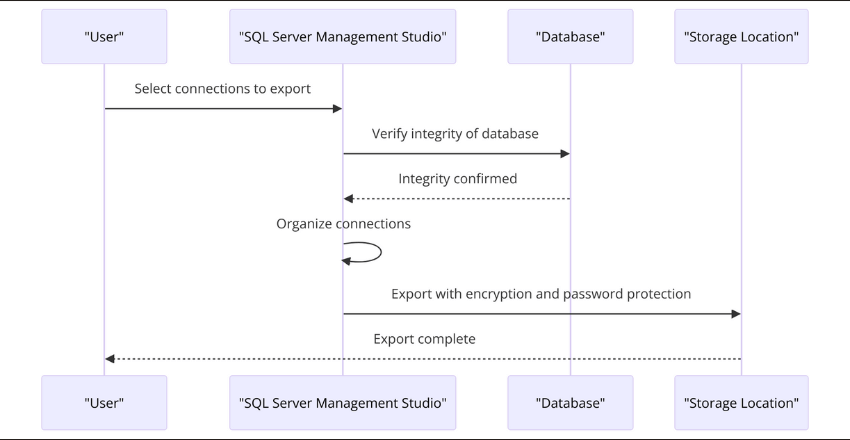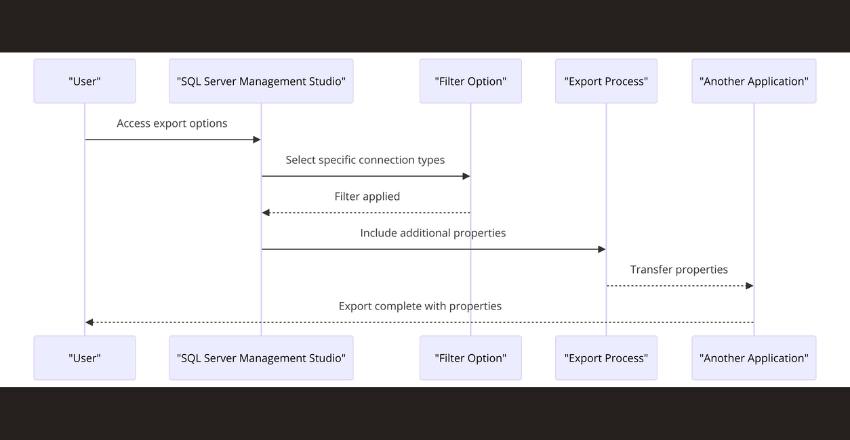
Exporting connections from SQL Server Management Studio streamlines data management, ensuring seamless integration across diverse platforms for enhanced operational efficiency.
Understanding SQL Server Management Studio
SQL Server Management Studio (SSMS) is a powerful tool for managing SQL databases. It is an integrated environment that provides a comprehensive set of tools for configuring, managing, and monitoring SQL Server instances and databases.
The main user interface of SSMS is organized into several windows, including Object Explorer, Query Editor, and Properties. Object Explorer is used to navigate through databases and database objects such as tables, views, and stored procedures. Query Editor is used to write and execute SQL queries. Properties window provides access to properties of selected objects, such as database settings and user permissions.
Why is SQL Server Management Studio important?
SQL Server Management Studio is essential for managing SQL databases because it provides a centralized location for performing common tasks such as database backup and restore, creating and modifying tables, and managing users and permissions. It also provides tools for monitoring database performance, analyzing queries, and generating reports.
Without SSMS, managing SQL databases would require using multiple tools and scripts, which can be time-consuming and error-prone. SSMS provides a streamlined and efficient workflow for managing all aspects of SQL databases.
Managing Database Connections
Efficiently managing database connections is crucial in ensuring the smooth operation of SQL Server Management Studio. A connection represents a link between SQL Server Management Studio and a SQL server instance, allowing the user to interact with the database. The more connections within the studio, the higher the probability of disorganized and unnecessary connections, which can impede the productivity of users.
There are several ways to manage database connections effectively in SQL Server Management Studio. Firstly, users can group connections by server or type to create a tidy and easy-to-navigate environment. Secondly, users can remove any unnecessary connections to declutter the workspace. Thirdly, users can rename connection names to ensure that they are easily identifiable and searchable.
Moreover, it is essential to ensure that only authorized personnel have access to the connections. One way to achieve this is by creating different user credentials for various connection types. SQL Server Management Studio allows setting up group policies to control access to specific connections by certain users.
In addition to these measures, users must also keep an eye on connection activity. SQL Server Management Studio allows users to view active connections and monitor them. This feature can help prevent unnecessary connections and maintain a clean workspace.
| Useful Keyboard Shortcuts for Connection Management |
|---|
| Ctrl + N: Create a new connection |
| Ctrl + Shift + N: Store new connection |
| Ctrl + U: Connect to a database |
| Ctrl + L: Close a connection |
Note: The above keyboard shortcuts can help users with connection management and ease the process of managing and accessing connections in SQL Server Management Studio.
Exporting Connections

To export connections from SQL Server Management Studio, follow these step-by-step instructions:
- Open SQL Server Management Studio.
- Click on the ‘Connect’ button to open the ‘Connect to Server’ dialog box.
- Enter the connection details for the server you want to export, then click ‘Connect’.
- In the ‘Object Explorer’ pane, right-click on the connection you want to export and select ‘Export’.
- In the ‘Export Connection’ dialog box, select the location and name for the exported file.
- Choose the export options you want to use (e.g., include passwords, include server settings).
- Click ‘Export’ to start the export process.
It is important to note that exporting connections requires administrative permissions for the server being exported. Additionally, some server settings may not be exported due to security or compatibility reasons.
To mitigate potential issues that may arise during the export process, we recommend creating backups of all connection information prior to exporting. This can be achieved by exporting individual connections or creating a backup of the entire connection repository.
For more granular control over the export process, advanced techniques can be employed. For example, specific connection types or connection properties can be selected for export. The exported file can also be customized to suit specific requirements, such as filtering or formatting options.
Overall, exporting connections from SQL Server Management Studio is a straightforward process that offers significant benefits in terms of organization, efficiency, and data security. By following best practices and utilizing advanced techniques, users can ensure a swift and secure export process that meets their specific needs.
Swift and Safe Exporting Methods

When exporting connections from SQL Server Management Studio, it is important to use efficient and secure methods to ensure a smooth process.
Here are some best practices for swift and safe exporting:
- Create a backup – Before exporting any connections, it is essential to create a backup of your database. This will ensure that no data is lost during the exporting process.
- Ensure data integrity – When exporting connections, it is vital to ensure that the data remains intact and is not corrupted during the export process. One way to accomplish this is to verify the integrity of your database before and after exporting connections.
- Use encryption – To protect confidential data, it is recommended to use encryption when exporting connections. SQL Server Management Studio provides the option to export connections with password protection and encryption, ensuring the security of sensitive information.
- Organize connections efficiently – Proper organization of connections in SQL Server Management Studio can save you time and make exporting connections more manageable. Organize your connections into groups, labels, or categories, making it easy to identify and locate specific connections when exporting.
To illustrate these methods, here is an example of exporting connections using password protection:
| Step | Code Example |
|---|---|
| Step 1 | Select the connections to export. |
| Step 2 | Right-click and choose “Tasks” -> “Export Data-tier Application…” |
| Step 3 | Enter the name and location where you want to save the export. |
| Step 4 | Click “Next” and select “Include passwords in the export” and “Encrypt passwords in the export”. |
| Step 5 | Click “Finish” to complete the export process. |
Following these best practices and utilizing the features of SQL Server Management Studio can help you achieve a swift and secure exporting process.
Troubleshooting Common Issues
While exporting connections from SQL Server Management Studio can be a straightforward process, certain issues may arise that can affect the outcome. Here are some common issues that users may experience and how to troubleshoot them.
1. Invalid credentials error
If you receive an “Invalid credentials” error when trying to export your connections, first ensure that you have entered the correct login information. Double-check the username and password you are using to access the server. If the issue persists, try resetting your password or contact your database administrator to ensure that your credentials are up to date and have the necessary permissions to export connections.
2. Exported file is empty or incomplete
If the file you exported is empty or incomplete, check to see if any filters or criteria were applied during the export process. Remove any filters or criteria that may be limiting the scope of the export. Additionally, check to see if there are any network connectivity issues or if the server is experiencing any downtime. If the issue persists, attempt to export the file again, ensuring that all necessary options, such as “Export to File”, are selected.
3. Exported file is too large
If the exported file is too large, consider using compression to reduce the file size. SQL Server Management Studio offers an option to compress the exported file during the export process. Additionally, consider exporting only the necessary connections or limiting the scope of the export to reduce the file size. If the issue persists, consider exporting the file in smaller increments or using an external tool to manage the export process.
4. Connection information is not preserved
If the exported file does not preserve the connection information, check to ensure that the appropriate options are selected during the export process. Ensure that the “Include Password” option is selected if you want to preserve password information. Additionally, check to see if the connection information is being overwritten during the import process. If the issue persists, try exporting the file using a different format or using an external tool to manage the export process.
By keeping these common issues in mind and following the troubleshooting tips provided, you can ensure a smooth and successful exporting process from SQL Server Management Studio.
Other Exporting Techniques

Once you have mastered the basics of exporting connections from SQL Server Management Studio, it’s time to explore advanced techniques for a more customized and efficient process. Here are some advanced exporting techniques that can help you streamline your workflow:
Exporting Specific Connection Types
In some cases, you may want to export only specific types of connections from SQL Server Management Studio. This can be useful if you have a large number of connections and want to filter out those that are irrelevant to your current project.
To do this, you can use the Filter option when exporting your connections. Simply select the connection types you want to export, such as “SQL Server” or “OLE DB”, and deselect the rest.
Exporting Connection Properties
By default, SQL Server Management Studio exports only basic information about your connections, such as server name and database name. However, you can also export additional connection properties, such as login credentials and connection string parameters.
This can be helpful if you need to transfer these properties to another application. To do this, select the Include password and sensitive information option when exporting your connections.
Example
It’s important to clarify that SQL Server Management Studio (SSMS) does not offer a built-in feature to export connection properties directly, including sensitive information like passwords, in a user-friendly manner for security reasons.
Handling login credentials and other sensitive information requires a careful approach to ensure security compliance and data protection.
However, I can guide you through a process that involves using a script to generate a connection string, which can then be manually adjusted to include sensitive data if necessary.
Keep in mind, storing or transferring sensitive information like passwords should always be done securely and in compliance with your organization’s data protection policies.
Generating a Basic Connection String
You can generate a basic connection string using T-SQL or PowerShell, but remember, you’ll have to manually add sensitive information in a secure manner.
T-SQL Approach for Basic Information
This script does not directly include sensitive information but can be a starting point:
DECLARE @ServerName NVARCHAR(128) = @@SERVERNAME,
@DatabaseName NVARCHAR(128) = DB_NAME();
SELECT 'Server=' + @ServerName + ';Database=' + @DatabaseName + ';
Integrated Security=True;' AS ConnectionString;This will generate a connection string using Windows Authentication. For SQL Authentication, you would manually adjust the string to include User ID and Password.
PowerShell Script to Retrieve and Format Basic Connection Properties
This PowerShell script snippet retrieves basic SQL Server connection properties:
$serverName = "YourServerName"
$databaseName = "YourDatabaseName"
$connectionString = "Server=$serverName;Database=$databaseName;
Integrated Security=True;"
Write-Output $connectionStringIncluding Sensitive Information
Manually adding sensitive information to your connection string should be done with caution. For SQL Authentication, append the User ID and Password to your connection string like so:
Server=YourServerName;Database=YourDatabaseName;
User Id=yourUsername;Password=yourPassword;Customizing the Export Process
If you need more control over the export process, you can customize it using scripting. SQL Server Management Studio allows you to generate a script that contains all the export commands, which you can then modify to suit your needs.
For example, you can add custom code to automate certain tasks or to export connections to a specific format or location. To do this, select the Script connection as option when exporting your connections and choose the appropriate scripting language.
With these advanced exporting techniques, you can take your SQL Server Management Studio workflow to the next level. Remember to always test your exports and backups to ensure data integrity and security.
Best Practices for Exporting Connections

Efficiently managing and exporting database connections is crucial for a well-organized and secure SQL environment. To ensure a smooth exporting process, follow these best practices:
1. Create Regular Backups
Before exporting connections, it is important to create regular backups of your SQL server and connection repository. This helps to prevent data loss and ensures that your connections can be restored in the event of a problem.
2. Organize Connections Effectively
Organizing your connections into categories that make sense for your organization can help to keep your connection repository well-organized and easily searchable. Consider creating categories by department, project, or application, for example.
3. Limit Access to Connection Information
Exporting connection information can be a potential security risk, so it is important to limit access to this information. Make sure to only share connection information with those who need it and consider encrypting your exported connection files.
4. Test Your Connections Regularly
Make sure to test your connections regularly to ensure that they are functioning properly. This helps to identify and address any issues before they become major problems and can save time and resources in the long run.
5. Use Parameterization
When exporting connection information, consider using parameterization to ensure that sensitive information, such as passwords, is not stored in plaintext. This adds an extra layer of security to your exported connection files.
6. Keep Your Connection Repository Up-to-Date
Regularly updating your connection repository can help ensure that you are not relying on outdated or incorrect information. Consider implementing a system for reviewing and updating connection information on a regular basis.
By following these best practices, you can ensure a secure and efficient exporting process for your SQL server management studio connections.
Next Steps
Now that you have learned how to export connections from SQL Server Management Studio, you have taken the first step in streamlining your database management process.
To ensure a smooth exporting process, it is important to follow the best practices covered in this guide. Creating regular backups and maintaining data integrity are just a few ways to ensure a swift and safe export. Additionally, following the tips for organizing and categorizing connections effectively will help to maintain a well-organized connection repository.
At HireSQL, we are dedicated to providing top-notch outsourcing services for your SQL database needs. Our team of dedicated SQL Database Developers are available to assist you with any questions or concerns you may have. Contact us today to learn more about our services and how we can help streamline your database management process.
External Resources
https://en.wikipedia.org/wiki/SQL
FAQ

FAQ 1: How can I export connection information from SQL Server Management Studio (SSMS)?
Answer: Exporting connection information directly from SSMS isn’t supported through a menu option or command. However, you can manually save your connection settings or script out the necessary information using SQL Server scripts.
For instance, to list out server information, you might use T-SQL to query server properties:
SELECT SERVERPROPERTY(‘MachineName’) AS MachineName,
SERVERPROPERTY('ServerName') AS ServerName,
SERVERPROPERTY('InstanceName') AS InstanceName,
SERVERPROPERTY('IsClustered') AS IsClustered;Explanation: This code retrieves the machine name, server name, instance name, and whether the server is part of a cluster. It doesn’t export connections per se but provides vital information about your current SQL Server environment.
FAQ 2: Can I automate the backup of my SQL Server Management Studio connection settings?
Answer: While SSMS does not provide a direct feature to backup or export connection settings through the GUI, you can manually backup the sqlstudio.bin file where these settings are stored. This file is located in your user profile’s AppData folder (e.g., C:\Users\[YourUsername]\AppData\Roaming\Microsoft\SQL Server Management Studio\[Version]\SqlStudio.bin).
Explanation: This approach involves navigating to the file location in the file system and copying the sqlstudio.bin file. It’s a manual method to ensure you have a backup of your connection settings that can be restored or transferred to another machine.
FAQ 3: How do I script out database connections for migration purposes from SSMS?
Answer: While you cannot directly export connection settings from SSMS, you can generate scripts for database objects and server-level objects that include details necessary for re-establishing connections on another system. Use the “Generate Scripts” wizard in SSMS:
- Right-click on your database in SSMS and select “Tasks” > “Generate Scripts”.
- Follow the wizard steps, selecting the database objects you wish to script.
- On the “Set Scripting Options” step, choose “Save scripts to a specific location”.
- Finish the wizard to generate the scripts.
Explanation: This process creates a SQL script that can be used to recreate the database schema and objects on another server. While it doesn’t export connection settings per se, it’s crucial for migrating databases and ensuring you can establish connections to the same database objects on a new server.







